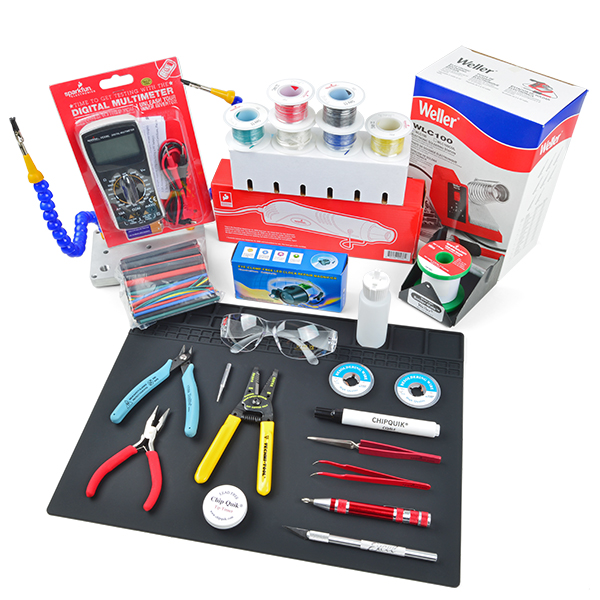SparkFun Deluxe Tool Kit
This is Sparkfun’s new Deluxe Tool Kit! We’ve picked our very best tools and put together the ultimate kit of items we use on a daily basis. Whether you’re a beginner looking to get into some serious hardware hacking, or just setting up a second workshop and need the complete kit, this has everything you need!
This latest edition of our deluxe tool kit adds several items, most notably the heaterizer, a third-hand kit, more hook-up wires, and our upgraded wire strippers and flush cutters!
Note: Sorry international folks, the SparkFun Deluxe Tool Kit only includes instruments with US power plug and voltage operation requirements.
- Weller WLC100 Soldering Station
- Heaterizer XL-3000 Heat Gun
- Digital Multimeter - Basic
- Insulated Silicone Soldering Mat
- SparkFun Third Hand Kit
- Pocket Screwdriver Set
- Monocle Magnifier - Illuminated
- Solder - 1/4lb Spool (0.032in.) Special Blend
- Solder Wick #2 5ft. - Generic
- Solder-Mate Solder Dispenser
- Soldering Tip - Weller - Standard (ST1)
- Solder Tip Tinner and Cleaner
- Chip Quik No-Clean Flux Pen - 10mL
- Hook-Up Wire - Assortment (Solid Core, 22 AWG)
- Heat Shrink Kit
- Wire Strippers - 20-30AWG
- Flush Cutters - Xcelite
- Needle Nose Pliers
- Tweezers - Straight (Cross-Lock, ESD Safe)
- Tweezers - Curved (ESD Safe)
- Hobby Knife
- SparkFun Safety Glasses
- Water Bottle - 2oz
SparkFun Deluxe Tool Kit Product Help and Resources
How to Work with Jumper Pads and PCB Traces
April 2, 2018
Handling PCB jumper pads and traces is an essential skill. Learn how to cut a PCB trace, add a solder jumper between pads to reroute connections, and repair a trace with the green wire method if a trace is damaged.
How to Use a Multimeter
January 9, 2015
Learn the basics of using a multimeter to measure continuity, voltage, resistance and current.
How to Solder: Through-Hole Soldering
September 19, 2013
This tutorial covers everything you need to know about through-hole soldering.
Core Skill: Soldering
This skill defines how difficult the soldering is on a particular product. It might be a couple simple solder joints, or require special reflow tools.
Skill Level: Noob - Some basic soldering is required, but it is limited to a just a few pins, basic through-hole soldering, and couple (if any) polarized components. A basic soldering iron is all you should need.
See all skill levels
Core Skill: DIY
Whether it's for assembling a kit, hacking an enclosure, or creating your own parts; the DIY skill is all about knowing how to use tools and the techniques associated with them.
Skill Level: Competent - You might need to break out the power tools. Nothing beyond a power drill or rotary tool should be required, but you might have a hard time with just a screwdriver and hammer. Cutting holes into plastic or metal might be required.
See all skill levels
Core Skill: Electrical Prototyping
If it requires power, you need to know how much, what all the pins do, and how to hook it up. You may need to reference datasheets, schematics, and know the ins and outs of electronics.
Skill Level: Rookie - You may be required to know a bit more about the component, such as orientation, or how to hook it up, in addition to power requirements. You will need to understand polarized components.
See all skill levels
Comments
Looking for answers to technical questions?
We welcome your comments and suggestions below. However, if you are looking for solutions to technical questions please see our Technical Assistance page.
Customer Reviews
No reviews yet.


At a added price, can the WE1010 be swapped for the WLC100 in the kit?
Sorry, we don't have the ability to swap out parts in a kit. I believe everything except the water bottle is available to purchase separately though.
The WLC100 in the current kit seems like a step backwards. It's a variable power iron but does not have closed loop temperature control, the feature that really takes soldering to the next level.
I did consider using the WE1010 that we carry, but I wanted to keep the price on the kit affordable (and it is still over $200). The WLC is still a pretty good iron for people getting started, and if you aren't just getting started you probably have enough stuff that the kit isn't cost effective for you anyway. In other words it was a matter of trying to find a balance which is always tricky.